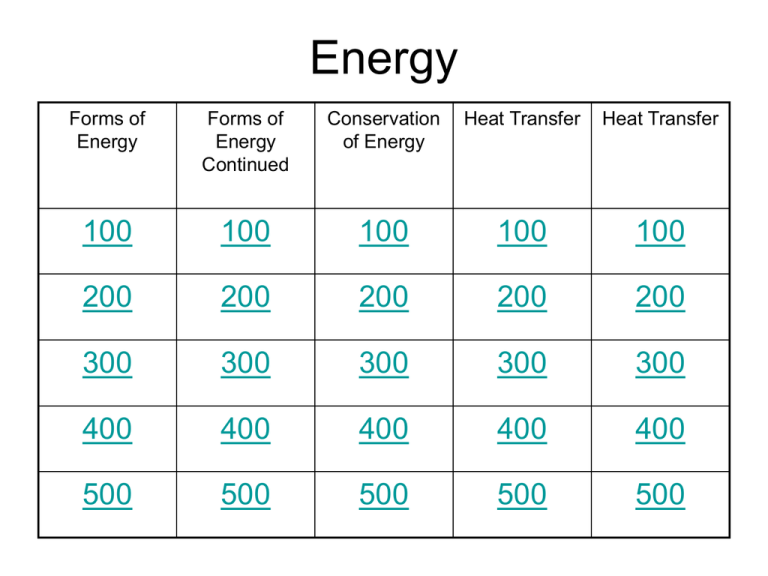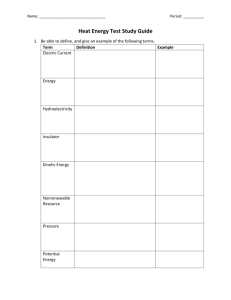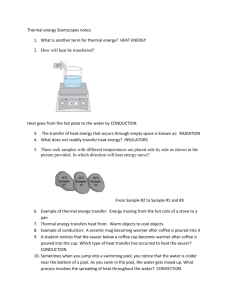Physical Science Review
advertisement

Energy Forms of Energy Forms of Energy Continued Conservation of Energy Heat Transfer Heat Transfer 100 100 100 100 100 200 200 200 200 200 300 300 300 300 300 400 400 400 400 400 500 500 500 500 500 Jan turns on a lamp so she can read. What type of energy provided by the lamp helps Jan read? A. B. C. D. Nuclear energy Electromagnetic energy Chemical energy Thermal energy Answer 100 points B. Electromagnetic Energy Home What kind of energy is produced by the vibrating particles when the strings of an acoustic guitar are plucked? A. B. C. D. Chemical energy Nuclear energy Electrical energy Sound energy Answer 200 points D. Sound Energy Home What kind of energy is involved in the movement of the blades of a windmill when moving air or wind strikes it? A. B. C. D. Mechanical energy Nuclear energy Electrical energy Electromagnetic energy Answer 300 points A. Mechanical Energy Home This is the energy associated with the motion of an object. A. B. C. D. Thermal Energy Electrical Energy Sound Energy Mechanical Energy Answer 400 points D. Mechanical Energy Home This is the total amount of energy in all of the particles contained in a sample of matter. Heat is often associated with this type of energy. A. B. C. D. Mechanical Energy Thermal Energy Sound Energy Electrical Energy Answer 500 points B. Thermal energy Home This is the type of energy that is stored in chemical bonds. For example, batteries have this type of energy. A. B. C. D. Nuclear energy Sound energy Electromagnetic energy Chemical energy Answer 100 points D. Chemical Energy Home Computers, radios, televisions, and lamps are all examples of devices that operate using this type of energy. A. B. C. D. Electrical energy Nuclear energy Thermal energy Mechanical energy Answer 200 points A. Electrical energy Home This type of energy results from the motion of particles within atoms. Light, x-rays, and microwaves are all examples of this type of energy. A. B. C. D. Nuclear energy Sound energy Electromagnetic energy Electrical energy Answer 300 points C. Electromagnetic energy Home This energy is given off by a vibrating object and travels in the form of waves. A. B. C. D. Nuclear energy Sound energy Electromagnetic energy Chemical energy Answer 400 points B. Sound energy Home This is the energy stored in the nucleus of an atom as a result of the nuclear forces. A. B. C. D. Mechanical energy Thermal energy Chemical energy Nuclear energy Answer 500 points D. Nuclear energy Home Which of the following correctly states the law of conservation of energy? A. Energy cannot be created or destroyed but can be converted from one form to another B. Energy can be created or destroyed, as well as being converted from one form to another C. Energy is created when it is converted from one form to another D. In most systems, some energy is destroyed and lost as heat Answer 100 points A. Energy cannot be created or destroyed but can be converted from one form to another Home At what point in the picture is the kinetic energy the greatest and potential energy lowest? 1 2 A. B. C. D. 1 2 3 4 3 4 Answer 200 points D. 4 Home Using the formula Potential Energy = mass x height what is the potential energy of a rock with a mass of 50 kg that rests at the edge of a cliff 125 meters high? A. 2.5J B. 50J C. 125J D. 6,250J Answer 300 points D. 6250 J Home If energy is never lost, then what causes a rolling ball to eventually stop? A. B. C. D. Momentum Potential energy Chemical energy Friction Answer 400 points D. Friction Home When energy is transformed from one form to another, some energy is often wasted in the form of A. B. C. D. Heat Water Ice Atoms Answer 500 points A. Heat Home Earth receives energy from the sun by A. B. C. D. Convection Conduction Radiation Temperature Answer 100 points C. Radiation Home You have four containers of water. The water in each container is at the same temperature. Which container has the greatest thermal energy? A. B. C. D. A 5-mL container A 10-mL container A 15-mL container A 50 mL container Answer 200 points D. A 50 mL container Home In what direction does heat move? A. B. C. D. From warmer to cooler objects From cooler to warmer objects Between objects of equal temperature In all directions Answer 300 points A. From warmer to cooler objects Home The picture below shows the movement of thermal energy from a hot liquid to a metal spoon. What method of heat transfer is occurring? A. B. C. D. Conduction Convection Radiation Temperature Answer 400 points A. Conduction Home In a toaster, electrical energy is converted into thermal energy within the coils inside the toaster. Heat from the coils is used to toast the bread. How is the heat from the coils transferred to the bread? A. B. C. D. Convection Conduction Radiation Currents Answer 500 points C. Radiation Home What type of heat transfer is occurring in the picture below? A. B. C. D. Conduction Convection Radiation None Answer 100 points A. Conduction Home What type of heat transfer is occurring in the picture below? A. B. C. D. Conduction Convection Radiation None Answer 200 points B. Convection Home What type of heat transfer is occurring in the picture below? A. B. C. D. Conduction Convection Radiation None Answer 300 points C. Radiation Home What type of heat transfer is occurring in the picture below? A. B. C. D. Conduction Convection Radiation None Answer 400 points B. Convection Home What type of heat transfer is occurring in the picture below? A. B. C. D. Conduction Convection Radiation All of the above Answer 500 points D. All of the above Home





![Applied Heat Transfer [Opens in New Window]](http://s3.studylib.net/store/data/008526779_1-b12564ed87263f3384d65f395321d919-300x300.png)